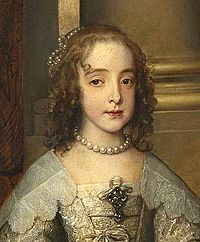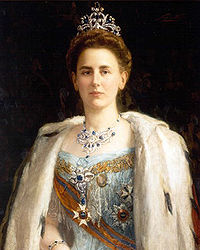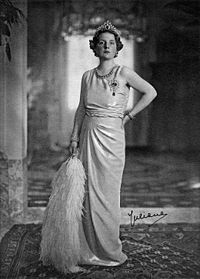- Dutch Royal Regalia
-
In comparison to many European monarchies' regalia, the Dutch Regalia are relatively new, having been commissioned by King Willem II in 1840. An earlier, more modest set of regalia made of silver were commissioned by King William I in 1815.[1]
The regalia of the Netherlands consist of the following:
- the crown, symbolising the sovereignty of the Kingdom of the Netherlands, which presently consists of the Netherlands in Western Europe and three overseas constituent countries in the Caribbean: Curaçao, Sint Maarten and Aruba. It also symbolises the dignity of the Sovereign as head of state. The crown was manufactured by the Amsterdam goldsmith Bonebakker. It is made of gilded silver, adourned with coloured stones and imitations of pearls.[2]
- the sceptre, symbolising the reigning King or Queen’s authority;
- the orb, symbolising the Sovereign territory;
Both sceptre and orb were made by court jeweler Meijer from The Hague.[3]
- the sword of state, standing for the Monarch's power;
- the Gonfalon of State (Rijksvaandel or Rijksbanier), a banner of white moiré silk suspended from a gilded spear, painted with the coat of arms of the Netherlands as decreed on the 24th of August 1815, symbolising the nation. The arms of the Netherlands have changed since 1815, but the depiction on the gonfalon has not.[4] The artwork was by Batholomeüs Johannes van Hove.[5]
All these objects, including the coronation mantle are only used at the enthronement of a King or Queen and have been given by Queen Juliana to the "Foundation Regalia of the House Orange Nassau".[6]
Contents
Usage
Dutch monarchs have never been physically crowned. During royal inaugurations, the crown, sceptre and orb are displayed on a table in the Nieuwe Kerk in Amsterdam, where the inaugurations take place. The Gonfalon of State and Sword of State are carried in the royal procession from Dam Palace to the Church and are held on either side of the royal dais in the Church during the swearing in ceremony.[7]
The Crown Jewels
Sometimes the regalia are dubbed "crown jewels". This is not exact. There are no crown-jewels that belong to the crown as an institution.
In the past the terms House-diamonds, House-jewels (Will of William I in 1841, Art. 12) and family jewels (1784 in the will of William V) have been used. In 1790 the term "Bijoux de la Couronne" was used by Luise of Brunswick -Wolfenbüttel aa the beneficiary of het large diamond from Borneo. In 1896 the Firm of van Kempen&Begeer wrote about resetting the jewels of the Crown ("juweleelen der kroon"). Queen Juliana gave a selection of her formal jewelry to the new Foundation Regalia of the House of Orange-Nassau, instituted on 27 July 1963. In 1968 a Foundation "Kroongoederen van het Huis van Oranje-Nassau" was instituted. It owns the regalia and the House-JEWELS.
The Houses of Orange and Nassau have collected a fabulous collection of jewels, including important diamonds an pearls. The famous Small Sancy diamond of 34 carat[8] was bought by Frederik Hendrik, it is now in the collection of the Prussian Royal Family. These collections have been dispersed several times. After the death of William III in 1702 there were several heirs in Germany, descendent of his grandfather Prince Frederik Hendrik. The famous Orange pearls were sent to Prussia. In the 19th century the daughters and granddaughters of William I and the daughter of William II were given a large collection of jewels when they married. The jewels are now by inheritance in the collections of the royal and princely families of Sweden, Danmark, Prussia and Saxen-Weimar. Consecutive Princes of Orange and Kings of the Netherlands have tried to institute a collection of crown-jewels that weren't a fideï comis and were therefore inseparable. They did not succeed. It was King William III of the Netherlands who decided that a number of gems and jewels were to be "the diamonds of the Crown". They were to be reserved for the ruling monarch and his consort.[9]
Amongst these "crown jewels" are large and old fashioned tiaras, devants the corsage and necklaces set with large emeralds, sapphires, diamonds and rubies. They are sometimes worn during state-banquettes.[10]
The most impressive solitaire in the collection is a dropshape rose-cut Indian diamond that once belonged to Queen Mary II of England. It is as "large as the egg of a dove and as clear as water". It is seldom worn and as the Dutch Royal family is very secretive the weight is unknown. The diamond has no official name but it has been referred to as the "Stuart" or "Holland" diamond in the past.[11]
The beautiful sets of diamonds, rubies and saphires that were given to Queen Wilhelmina and Queen Juliana were not legally part of these collection. The set of jewels containing 800 diamonds and the famous "Garuda" bracelet from the Dutch East Indies that were given to the then Princess Juliana were broken up after their deaths. The stones are now part of several earrings, brooches and other jewels.[12]
References
- ^ A.J.P.H. van Cruyningen, De inhuldiging van de Nederlandse vorst. Van Willem Frederik tot Beatrix Wilhelmina Armgard (unpublished MA thesis, Katholieke Universiteit Nijmegen, 1989) 61.
- ^ Van Cruyningen, 61-62.
- ^ Van Cruyningen, 62.
- ^ Kl. Sierksma, Nederlands vlaggenboek. Vlaggen van Nederland, provincies en gemeenten (Utrecht/Antwerpen: Het Spectrum 1962, 17.
- ^ http://beeldbank.nationaalarchief.nl/na:col1:dat534445
- ^ René Brus
- ^ Van Cruyningen, passim.
- ^ [1]
- ^ René Brus
- ^ René Brus
- ^ René Brus
- ^ René Brus
Literature
- René Brus; "De juwelen van het Huis Oranje-Nassau, Haarlem 1996.
External links
Crown jewels by country Austria · Brazil · Czech Republic · Denmark · France · Germany (Bavaria · Prussia) · Greece · Hungary · Holy Roman Empire · Iran · Ireland · Japan · Malaysia · Madagascar · Netherlands · Nigeria · Norway · Poland · Romania · Russia · Serbia · Spain · Sweden · Thailand · United Kingdom (Scotland · Wales)Former or historical sovereign states shown in italicsCategories:- Crown jewels
- National symbols of the Netherlands
- Regalia
Wikimedia Foundation. 2010.




